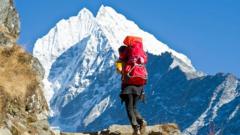Nepal's tourism sector is taking a bold step to expand its climbing opportunities and attract more visitors. The government recently announced that for the next two years, it will make climbing 97 lesser-known peaks in the Himalayas free of charge. This initiative is part of a broader effort to diversify tourism, particularly as interest surges for Mount Everest, the globe's highest mountain.
The Tourism Department's new approach comes alongside a significant rise in Everest climbing fees set to jump to $15,000 (£11,170) starting this September—the first such increase in nearly a decade. Officials aim to showcase the diverse range of unexplored destinations across the country, particularly in the remote Karnali and Sudurpaschim provinces, which are regarded as some of Nepal's least developed areas.
Climbing has historically served as a crucial revenue stream for Nepal. Last year alone, the mountaineering sector generated approximately $5.9 million, with Everest climbing contributing to over 75% of that income. However, despite the awe-inspiring beauty of the 97 peaks, these remote areas see minimal tourism activity primarily due to difficult accessibility. Nepal’s Tourism Department director, Himal Gautam, expressed hopes that the fee waiver will encourage more visitors, potentially creating economic opportunities and jobs for local communities.
Yet, the effectiveness of this initiative is uncertain. Local infrastructure improvements and the capability of these communities to manage an increase in climbers remain significant concerns. From 2021 to 2023, only 68 climbers ascended these designated 97 peaks. In stark contrast, 421 permits to climb Everest were issued for a single year, underscoring the existing disparity in tourist interest.
The discussion surrounding Everest climbing has also been heightened by environmental dilemmas and safety incidents. Following a recent Supreme Court ruling in April 2024, the Nepali government is now urged to regulate the number of climbing permits granted for Everest and other significant mountains, emphasizing the need to respect their natural capacities.
Additionally, a proposed parliamentary law would require climbers to have previously summited a peak over 7,000 meters in the country before being eligible to attempt Everest. This positions the newly free-to-climb peaks in Karnali and Sudurpaschim as "ideal training grounds," potentially refining the mountaineering experience in Nepal.
As Nepal strives to promote more diverse trekking experiences while grappling with the pressures of Everest, the future of its mountain tourism sector appears to be at a pivotal crossroads.





















